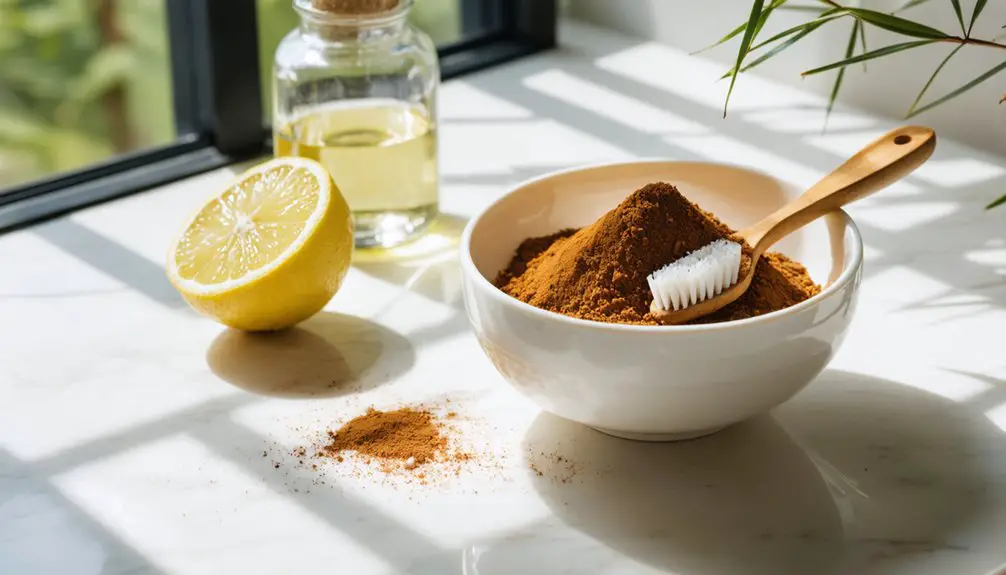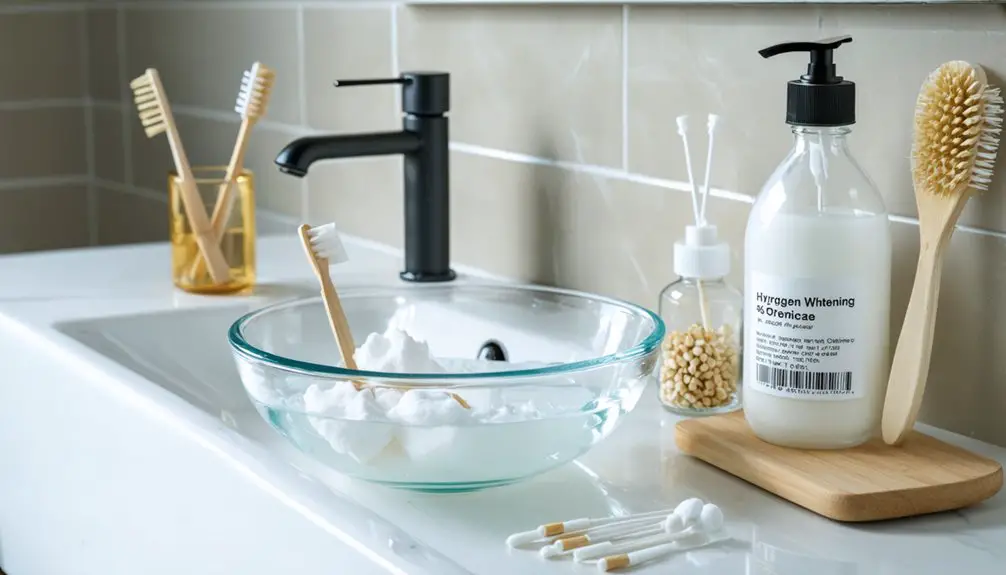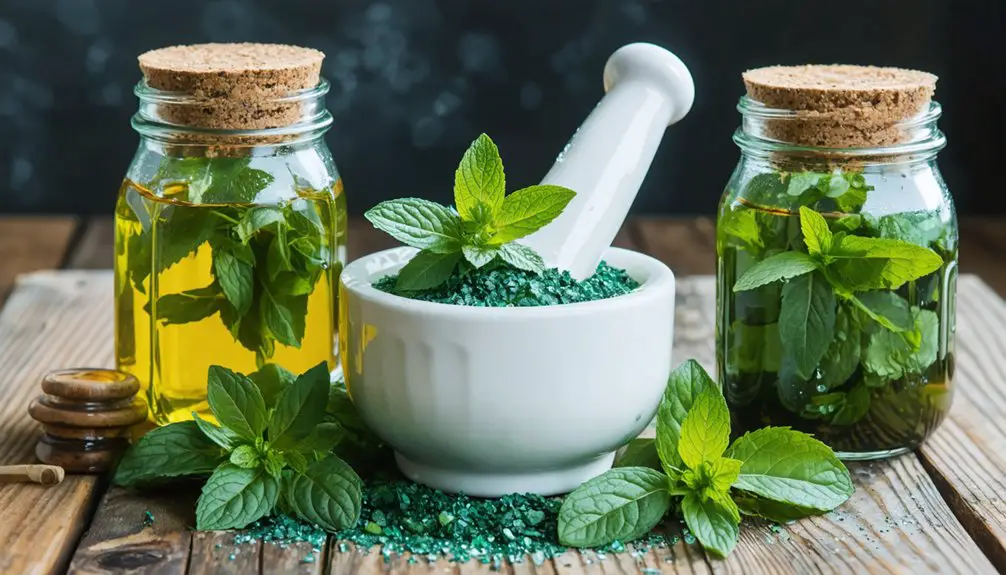While cinnamon has natural antimicrobial properties that can support oral health, it’s crucial to use it safely for teeth whitening. You’ll need to dilute cinnamon oil properly (0.07% to 0.1%) with carrier oils like coconut or jojoba. Don’t apply pure cinnamon directly to teeth or gums, as this can cause irritation. For best results, combine cinnamon treatments with professional dental care and natural alternatives. Our detailed guide will show you the safest and most effective techniques.
Key Takeaways
- Mix one drop of cinnamon essential oil with 15ml coconut oil for a safe, antimicrobial teeth-whitening paste.
- Apply diluted cinnamon mixture after regular brushing, using a soft-bristled toothbrush for two minutes, 2-3 times weekly.
- Combine cinnamon with natural whitening agents like baking soda or strawberries for enhanced stain-fighting properties.
- Document progress with weekly photos in natural lighting while monitoring for sensitivity or gum irritation.
- Avoid staining foods and beverages for 48 hours after cinnamon treatments to maximize whitening results.
Understanding Cinnamon’s Role in Oral Health
Nature’s potent spice, cinnamon plays a remarkable role in oral health through its diverse therapeutic properties. When you incorporate cinnamon into your oral hygiene routine, you’ll tap into its powerful antimicrobial and anti-inflammatory capabilities that target harmful bacteria and soothe irritated tissues.
The essential oils in cinnamon work effectively against common oral pathogens that cause tooth decay and gum disease. Recent studies show that nanoemulsion techniques significantly enhance cinnamon’s ability to penetrate and fight bacteria. You’ll find its active compounds, like cinnamaldehyde and eugenol, disrupting bacterial growth while fighting fungi such as Candida albicans. Ceylon cinnamon offers the safest option for daily oral care applications.
Among the key cinnamon benefits is its ability to reduce biofilm formation, which helps prevent cavities and periodontal issues. Additionally, it addresses bad breath by targeting odor-causing bacteria rather than merely masking unpleasant smells, making it a valuable natural addition to your dental care arsenal.
The Science Behind Cinnamon and Tooth Staining
You’ll find that cinnamon’s effects on tooth staining are closely tied to its unique chemical composition, particularly its antimicrobial compounds like cinnamaldehyde and eugenol.
While many foods contain tannins that can discolor your teeth, cinnamon actually helps prevent staining by inhibiting bacteria that contribute to extrinsic tooth discoloration. Unlike high-tannin beverages like black tea and red wine, cinnamon doesn’t contribute to surface staining on teeth.
Your teeth can benefit from cinnamon’s natural ability to reduce bacterial growth and biofilm formation, which are primary factors in tooth staining. Research shows that cinnamon oil compounds effectively combat Streptococcus mutans, a bacteria commonly associated with tooth decay and discoloration.
Tannins Cause Tooth Discoloration
While many people associate tooth staining primarily with coffee and wine, understanding the role of tannins provides essential insight into how discoloration occurs.
These naturally occurring compounds found in many popular beverages and foods bind strongly to your teeth’s enamel, creating stubborn stains that deepen over time. These organic compounds promote tooth decay by attracting proteins and sugars to your teeth’s surface.
When you consume tannin sources like tea, wine, or grapes, you’re exposing your teeth to compounds that actively promote staining by helping other pigments stick to your enamel. Tannins play a significant role as a natural defense mechanism in plants.
- Tannins work with acidic foods to soften enamel, making teeth more susceptible to staining
- Adding milk to tannin-rich beverages can help reduce staining potential
- Regular dental cleaning helps remove tannin buildup before it becomes severe
- Immediate rinsing after consuming tannin sources aids in staining prevention
Chemical Composition Affects Staining
Understanding cinnamon’s chemical composition reveals why it may contribute to tooth staining rather than whitening. Key compounds like cinnamaldehyde, eugenol, and phenols can bind to your tooth surfaces, leading to discoloration over time.
When these cinnamon compounds interact with your enamel, they don’t provide any bleaching effect.
The presence of tannins and resins in cinnamon further compounds the staining issue. As these substances make contact with your teeth, they can create extrinsic stains that become more noticeable with repeated exposure.
While cinnamon’s antimicrobial properties may benefit your oral health by fighting bacteria, the enamel interaction with its chemical components won’t produce whitening results. Research shows that cinnamon can cause unacceptable color changes to tooth enamel. Consulting with a dental professional first is essential before trying any natural tooth whitening remedies.
Instead, you’ll likely experience the opposite effect, as the natural pigments in cinnamon can leave lasting discoloration on your tooth surfaces.
Essential Oil Benefits for Dental Care
As dental care continues to evolve, essential oils have emerged as powerful natural allies in maintaining oral health. Their antimicrobial properties make them effective against common oral pathogens that cause decay and gum disease.
Essential oil applications range from reducing inflammation to fighting bacteria, while also providing natural alternatives to synthetic dental products. Since 2000 BC, civilizations have used these natural remedies for oral care. When used in small amounts, essential oils can promote oral microbiome health without disrupting the natural balance.
- Clove and peppermint oils offer dual benefits – pain relief and bacterial control
- Tea tree oil effectively combats plaque buildup and fungal infections
- Cinnamon oil’s antiseptic properties help prevent tooth decay while supporting whitening
- Lavender oil reduces anxiety during dental visits, improving treatment outcomes
You’ll find these natural compounds particularly useful in daily oral care routines, whether through oil pulling, adding drops to toothpaste, or using essential oil-infused dental products.
Their antioxidant properties help protect your oral tissues while promoting overall dental health.
Safe Dilution Methods for Cinnamon Oil
When working with cinnamon oil for dental care, you’ll need to follow strict dilution ratios of 0.07% to 0.1% to prevent oral tissue irritation.
You can achieve safe dilution by mixing 1-2 drops of cinnamon oil with 10ml of carrier oil such as coconut or MCT oil.
Before applying any diluted cinnamon oil mixture to your teeth or gums, you must conduct a patch test and avoid direct contact with sensitive oral tissues.
Proper Dilution Ratios Matter
Since cinnamon oil’s potency can harm oral tissues when used incorrectly, proper dilution is essential for safe teeth whitening. For ideal oral safety, you’ll need to dilute cinnamon oil to 0.5-1% concentration using a carrier oil like coconut, olive, or sweet almond oil. A simple ratio to remember is one drop of cinnamon oil per two teaspoons (10ml) of carrier oil.
- Use organic, unrefined carrier oils to maximize oral health benefits while diluting.
- Mix diluted cinnamon oil with coconut oil for oil pulling sessions lasting 10-20 minutes.
- Add 1-2 drops of properly diluted mixture to your regular toothpaste.
- Create a mouth rinse by combining 1-2 drops with 1 oz warm water.
Never use undiluted cinnamon oil, as it can cause burns or allergic reactions to your gums and mouth tissues.
The dilution importance can’t be overstated for protecting your oral health.
Essential Oil Safety Steps
The safe handling of cinnamon oil requires strict adherence to essential safety protocols before beginning any teeth whitening treatment.
Before using cinnamon oil, conduct a patch test on your inner arm to check for cinnamon allergies or skin sensitivities. Wait 24 hours to verify no adverse reactions occur.
Never apply undiluted cinnamon oil directly to your gums or mouth tissues, as this can cause severe burns and irritation. Keep the oil in safe storage – away from children, in a cool, dark place with child-proof caps.
If you experience any burning, swelling, or discomfort during use, rinse your mouth thoroughly with water immediately.
Those with known sensitivities, respiratory conditions, or existing oral inflammation should avoid using cinnamon oil altogether and consult their healthcare provider first.
Carrier Oils for Cinnamon
Proper dilution of cinnamon oil stands as a fundamental safety requirement for teeth whitening applications. To guarantee safety, select a carrier oil that complements your skin type and provides additional benefits.
When mixing cinnamon oil for dental use, maintain a dilution ratio of 0.07% to 0.1% – approximately one drop of cinnamon oil per 15ml of carrier oil.
- Coconut oil offers superior moisturizing properties and antimicrobial benefits for oral care.
- Jojoba oil mimics natural skin oils, reducing irritation risk around the mouth area.
- Sweet almond oil provides a light, non-greasy base ideal for sensitive gums.
- Grapeseed oil’s antioxidant content helps protect oral tissues during whitening.
Always measure precisely using droppers or calibrated tools to achieve the correct dilution.
Test the mixture on a small area first to check for any sensitivity before full application.
Combining Cinnamon With Professional Dental Care
Professional dental care and cinnamon-based products can work together effectively when you choose clinically validated formulations. For ideal results, select professional whitening toothpastes like Supersmile or Crest that incorporate cinnamon as a flavor rather than relying on cinnamon alone for whitening effects.
While cinnamon benefits include antimicrobial properties that support oral health, its role in whitening is limited. Instead, focus on products containing proven whitening agents like Calprox®, which can brighten teeth by up to 6 shades while being gentler on enamel.
The pleasant cinnamon taste promotes dental compliance, encouraging consistent brushing habits that maintain your professional whitening results.
Remember to consult your dentist before starting any whitening routine, as they’ll help you choose products that complement your existing dental care plan without risking gum irritation or tooth sensitivity.
Natural Alternatives to Chemical Whitening
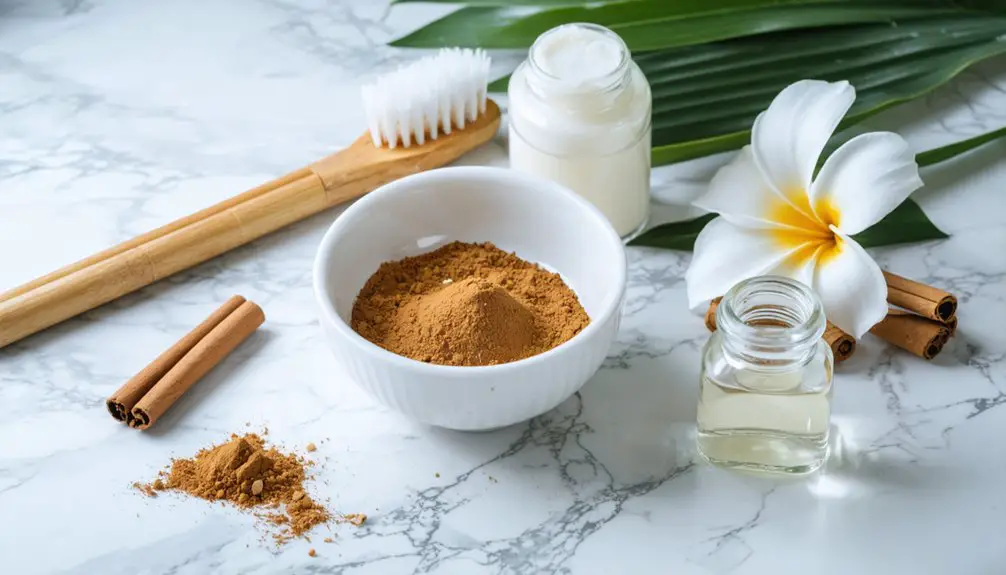
Many people seeking whiter teeth can achieve effective results through natural alternatives to chemical treatments. When considering options beyond cinnamon benefits, you’ll find several effective methods that support oral hygiene while brightening your smile.
Natural teeth whitening alternatives offer effective solutions without harsh chemicals, supporting both a brighter smile and overall oral health.
Natural abrasive agents like baking soda and crunchy fruits provide gentle cleaning action, while enzymatic solutions like oil pulling with coconut oil offer antimicrobial properties.
- Increase saliva production naturally with sugar-free gum to help neutralize staining acids
- Use fruits containing malic acid, such as strawberries, for mild whitening effects
- Try oil pulling with coconut oil to reduce bacteria that cause yellowing
- Incorporate crunchy vegetables and fruits that act as natural tooth scrubbers
These alternatives are generally safer than harsh chemicals, though results may take longer to achieve.
Remember to maintain consistent oral care habits for the best results.
Preventing Tooth Discoloration From Cinnamon
While cinnamon’s tannins can stain your teeth, you can minimize discoloration by properly diluting cinnamon products with water before use.
It’s essential to limit direct contact between cinnamon and your teeth by rinsing thoroughly after each application.
You’ll achieve better results by timing your cinnamon use strategically, such as avoiding prolonged exposure and not using it immediately before bedtime.
Safe Dilution Methods
Safe dilution of cinnamon is essential to prevent tooth discoloration while harnessing its whitening potential.
When preparing cinnamon mixtures, you’ll want to combine the spice with appropriate carrier substances using proper dilution techniques. Choose baking soda or coconut oil as your base to minimize staining risks while maximizing whitening benefits.
- Mix one drop of cinnamon oil per teaspoon of carrier oil or water to protect your oral tissues.
- Combine powdered cinnamon with baking soda in equal parts for a gentle whitening paste.
- Dilute cinnamon powder in water for a safe mouthwash solution.
- Blend a small amount of cinnamon with your regular fluoride toothpaste.
Remember to avoid acidic carriers like lemon juice or vinegar, as these can damage your enamel when combined with cinnamon.
Always verify you’re using pure, food-grade cinnamon products for ideal safety.
Timing Your Cinnamon Use
Proper timing of cinnamon-based teeth whitening treatments plays a crucial role in preventing unwanted discoloration and protecting your oral health.
Apply cinnamon treatments early in the day rather than before bedtime to minimize prolonged exposure to tannins. After professional teeth whitening, wait several days before using any cinnamon products, as your enamel will be more vulnerable to staining.
When you do incorporate cinnamon into your oral hygiene routine, use it after regular brushing with fluoride toothpaste, and always rinse thoroughly afterward.
Limit your cinnamon applications to once weekly rather than daily, and keep exposure brief. Choose Ceylon cinnamon for gentler treatment, and avoid combining it with acidic foods or abrasive agents.
If you notice any sensitivity or discoloration, discontinue use and consult your dental professional.
Proper Application Techniques and Timing
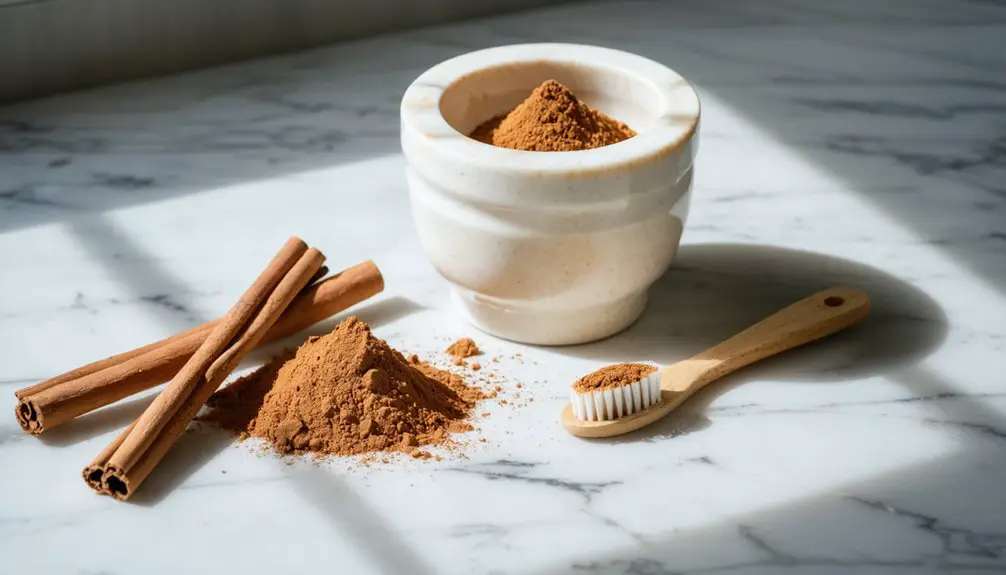
To achieve ideal teeth whitening results with cinnamon, you’ll need to follow specific application methods and timing guidelines. For best cinnamon benefits while ensuring enamel protection, blend the spice with carrier substances like coconut oil or baking soda before application.
Use a soft-bristled toothbrush to gently apply the mixture for two minutes, reaching all tooth surfaces.
- Apply your cinnamon treatment after regular brushing, a few times weekly rather than daily
- Mix 10-20 drops of cinnamon essential oil with coconut oil or baking soda for a balanced paste
- Store your mixture in a sealed container to maintain freshness
- Wait before consuming acidic or staining foods after treatment to maximize whitening results
Remember to rinse thoroughly after each application and monitor your gums for any sensitivity.
Common Mistakes to Avoid With Cinnamon Use
While cinnamon offers potential teeth whitening benefits, many users make critical mistakes that can damage their oral health. You’ll need to be mindful of proper cinnamon dosage to protect your teeth and gums.
Don’t apply cinnamon directly to your teeth multiple times per day, as this can lead to enamel damage and increased sensitivity.
For ideal enamel care, avoid mixing cinnamon with abrasive substances or using it alongside staining agents like coffee or tea.
If you notice any gum irritation, redness, or oral discomfort, stop using cinnamon immediately. Those with known allergies or sensitivities should consult a dental professional before incorporating cinnamon into their oral care routine.
Remember that excessive use can actually counter whitening effects by causing discoloration and compromising your tooth’s protective layer.
Monitoring Results and Adjusting Your Routine

Successfully monitoring your cinnamon-based whitening results requires consistent tracking and documentation of changes in tooth color.
You’ll want to evaluate your progress every few weeks and make routine adjustments based on your sensitivity levels and desired whitening goals. Remember that natural teeth whitening methods typically take longer than professional treatments, so patience is essential.
- Take weekly photos of your teeth in natural lighting to track gradual improvements
- Document any sensitivity or gum irritation you experience during treatment
- Maintain a log of how frequently you’re using the cinnamon treatment
- Record which foods you’re consuming that might affect your results
If you notice increased sensitivity, reduce the frequency of applications.
You can extend your results by avoiding staining foods and drinks for at least 48 hours after each treatment session, while staying well-hydrated throughout your whitening journey.
Frequently Asked Questions
Can Cinnamon-Based Treatments Reverse Existing Deep Tooth Stains?
No, cinnamon-based treatments won’t remove deep tooth stains. Their stain removal effectiveness is limited, and they may actually worsen discoloration. You’ll need professional treatment for significant whitening results.
How Long Should I Wait After Eating Before Using Cinnamon Oral Care Products?
You’ll need to wait 30-60 minutes after eating to protect your teeth sensitivity. For ideal oral hygiene with cinnamon products, extend this to 48 hours if you’ve recently had whitening treatments.
Will Cinnamon Oil Interact With My Prescription Mouth Rinse or Medications?
Like mixing oil and water, cinnamon oil doesn’t blend well with prescription mouth rinses. You’ll want to avoid using them together, and if you take medications, consult your doctor about potential interactions.
Does Organic Versus Non-Organic Cinnamon Make a Difference in Teeth Whitening?
No, cinnamon varieties (organic or non-organic) won’t affect teeth whitening differently. While both offer similar oral health benefits, neither type contains natural bleaching agents that whiten your teeth.
Can Children Use Cinnamon-Based Oral Care Products Safely?
Protect your precious ones – don’t use cinnamon-based oral care products for children. You’ll want to avoid potential allergic reactions, mouth irritation, and safety concerns linked to possible contamination risks.
References
- https://www.thip.media/health-news-fact-check/fact-check-can-toothpaste-and-cinnamon-make-your-teeth-whiter/69558/
- https://pmc.ncbi.nlm.nih.gov/articles/PMC7571082/
- https://medicaldialogues.in/fact-check/fact-check-can-a-mixture-of-mango-seed-neem-cinnamon-and-nutmeg-make-teeth-as-white-as-pearls-135771
- https://pmc.ncbi.nlm.nih.gov/articles/PMC6369603/
- https://raleighdentalloft.com/benefits-of-essential-oils-for-teeth-whitening/
- https://pubmed.ncbi.nlm.nih.gov/32932678/
- https://dental.dpu.edu.in/blogs/cinnamon-oral-health-benefits-smile
- https://www.nature.com/articles/s41598-021-85375-3
- https://www.healthline.com/nutrition/cinnamon-for-gums
- https://pmc.ncbi.nlm.nih.gov/articles/PMC10600304/
